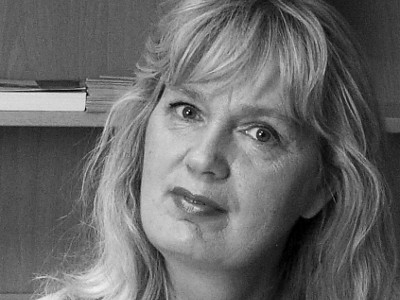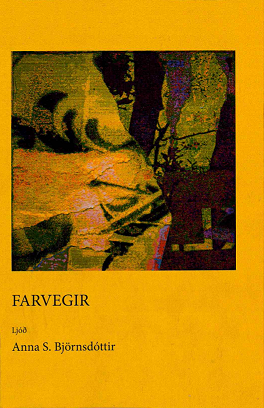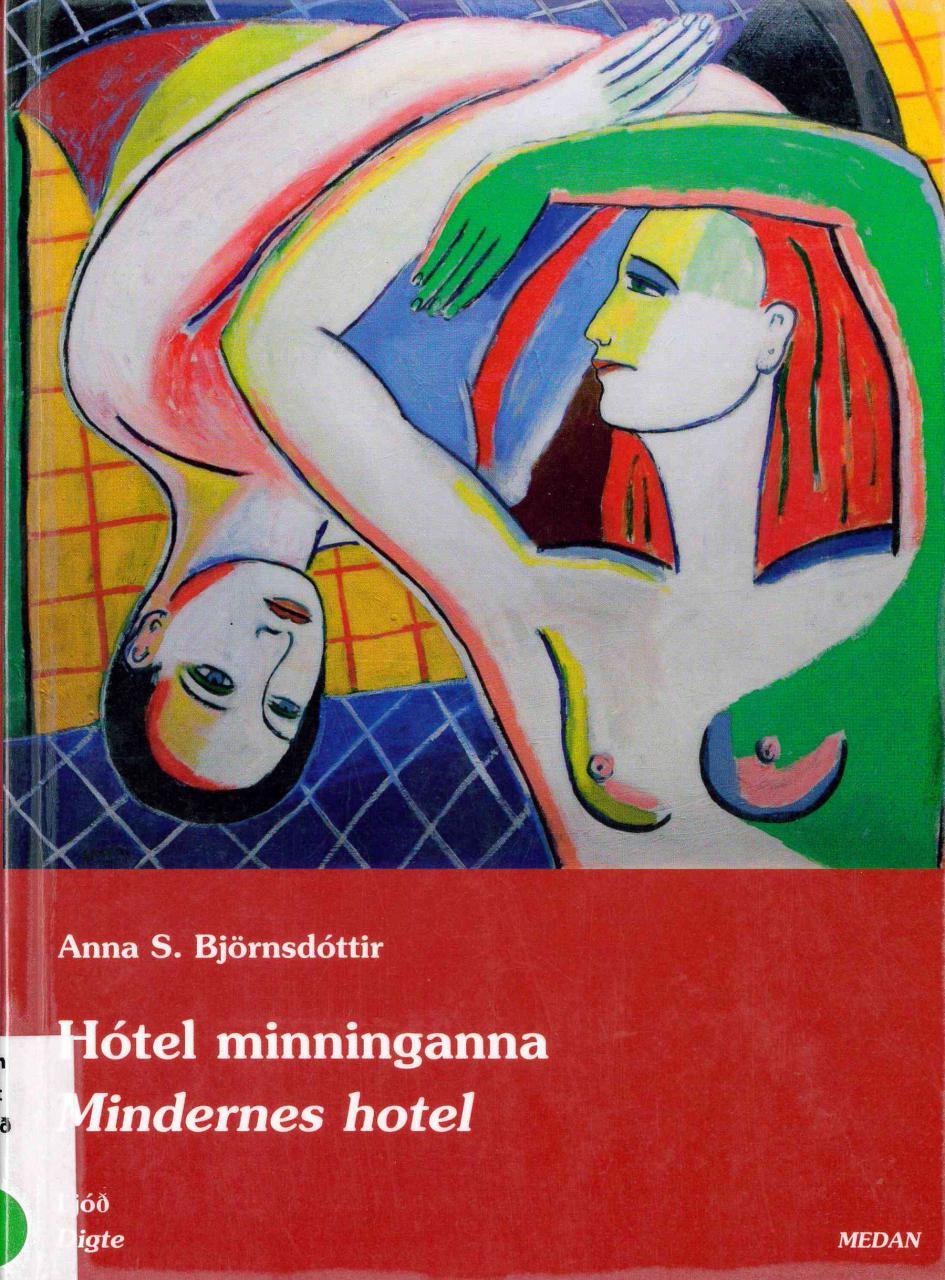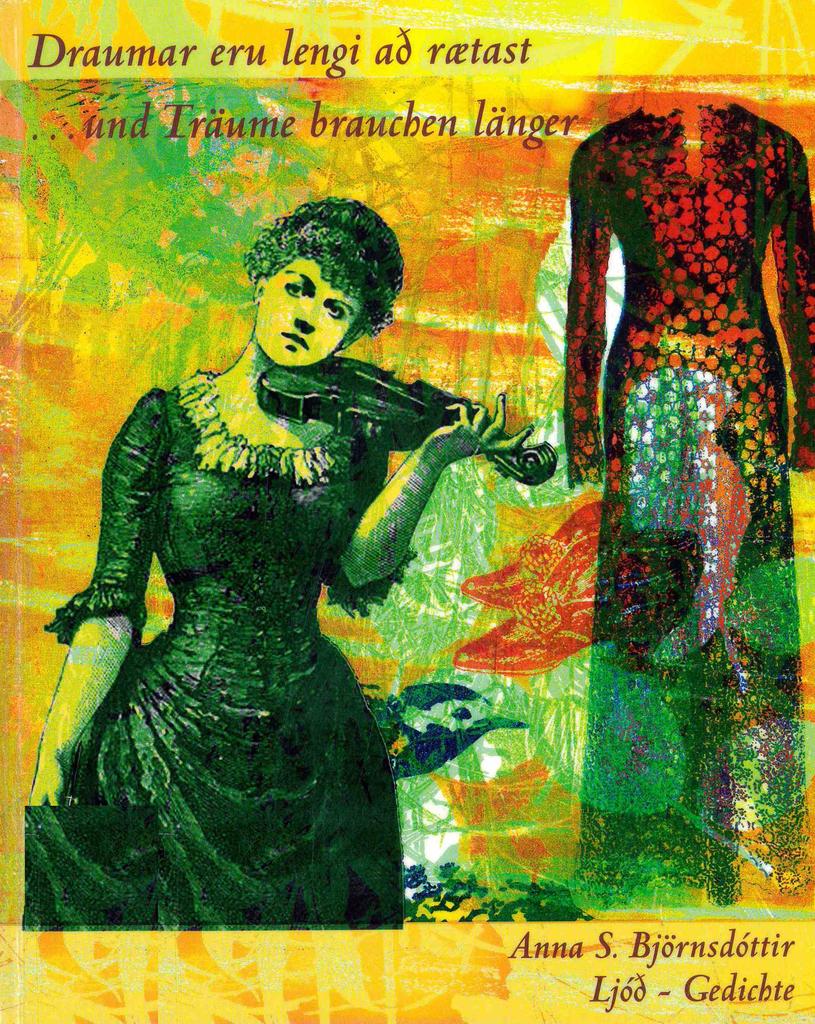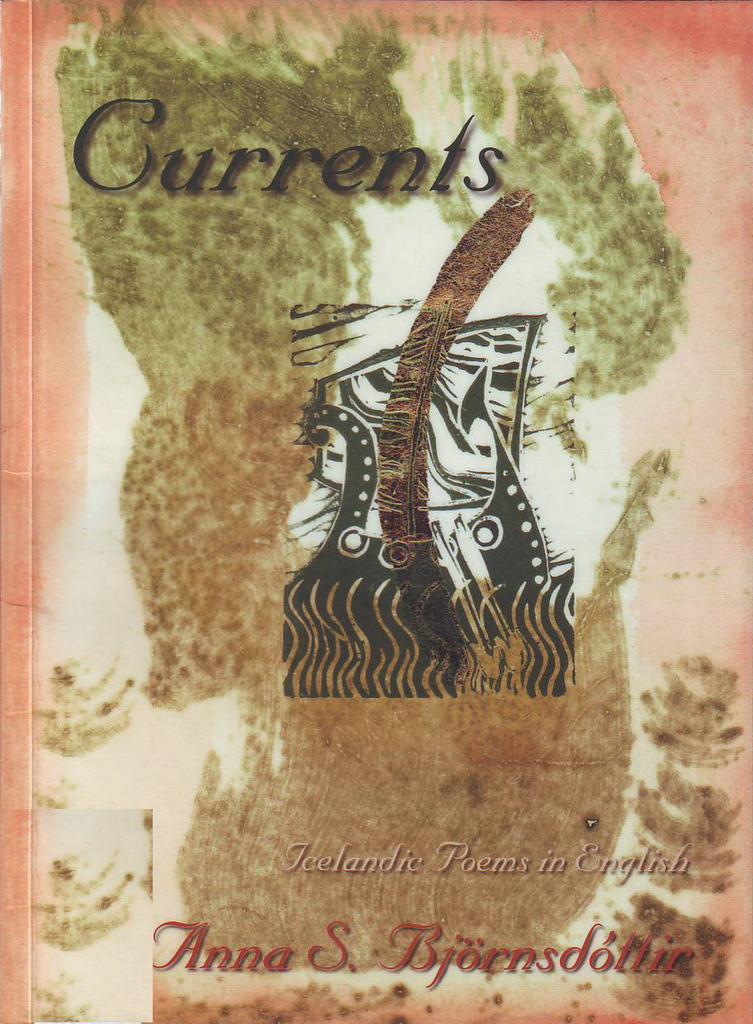Bio
Anna Svanhildur Björnsdóttir was born in Reykjavík on November 30, 1948. She grew up in Reykjavík, second of four siblings. Anna finished a teaching diploma in 1969 and then moved to Hólmavík in North Iceland where she lived for two years with her first husband. Anna later moved to Snæfellsnes in West Island with her two sons and stayed there for one year teaching. She worked on as a teacher in Reykjavík, married again and had two more children with her husband, Einar Aðalsteinsson, who passed away in 1998. She has also taught in Húsavík in north Iceland.
Anna started publishing poetry in newspapers and magazines in 1985, and her first book of poetry, Örugglega ég (Definitely Me) appeared in 1988. She has published a number of poetry collections since then, and taken part in numerous poetry happenings in Iceland and abroad, mostly in Scandinavia. Many of her poems have been translated to Danish, Swedish and English, and her book Mens solen stadig er fremme / Meðan sól er enn á lofti (While the Sun is Still Up) came out bilingually in Icelandic and Danish. Her poems have also been published in foreign poetry collections. Anna has been the publisher of most of her books, except Mens solen stadig er fremme which was published by Salka publishing house in 2003. She has been a member of the Icelandic Writer's Association since 1991.
About the Author
Sölvi Björn Sigurðarsson: The Poetry of Anna S. Björnsdóttir
Anna S. Björnsdóttir is a very personal poet who uses poetry to tackle some of this life´s most complex concepts, like love and sorrow. The passing of time and the human condition, especially the female aspect, are some of her favourite themes, as her seven published books of poetry attest to. They all have a certain flavour to them and that can be traced to those expansive themes and the simple terms the poet chooses to express herself with most of the time.
Anna´s first book of poems was published in 1988 and is called Örugglega ég (Definitely Me). It contains twenty four poems who all have at the centre the above-mentioned fundamental themes of the human existence. In her battle with love and time the poet takes her imagery from nature and weaves her hopes and disappointments around sunshine, rain, moonlight, flowers, sandy beaches, the rainbow and other images from nature that appeal to her emotions and sense of beauty. Many of her poems describe lovers at both good times and bad and some seem to be written directly to a lover who may not be fully committed to the narrator, as in Anna´s poetry happiness is rarely without doubts and in various ways connected to the dark sides of life. Her views on love are clearly expressed in the poem "Brennandi sólskin" (Burning sunshine) from Örugglega ég:
Að elska
er að játast þjáningu
sem gefur lífinu
lit og skugga.Að elska
er að standa aleinn
í brennandi sólskini,
langa að flýja
en geta sig hvergi hrært.(To love
is to accept suffering
that gives life
colour and shadow.To love
is to stand alone
in burning sunshine,
wanting to flee
unable to move.)
This easily understood description of emotions is the hallmark of Anna S. Björnsdóttir´s poetry. Complex stylistics or exotic images are rarely to be found in her work, she focuses on the obvious things that are often obscured by the hustle and bustle of everyday life. Affairs of the heart are complex in their simplicity and poetry enables Anna to ponder this and share her conclusions with the reader in a clear and personal way. She does not rely on meter or poetics, it seems as if the poems spring directly from her thoughts and that these thoughts find their way directly onto the page after some deliberation. It is this emotional frankness that makes the poetry of Anna Björnsdóttir so personal, even if the emotions are sometimes framed in an abstract context although very rarely. It is fairly obvious that the poet wants to convey her experience directly to the reader, not the generic experience of the world or that of the collective human spirit, but the definite personal experience that is the material of all her poems. When discussing her own poetry here on this website Björnsdóttir says that the book Strendur (Beaches) contains many poems describing her own depression. In that book as in many of her books the narrator speaks directly to a certain reader and the pronouns "I", "you" and "us" are common and indicate that these poems are written from certain situations in the life of the poet. An example of this is the poem "Sorg" (Sorrow):
Þú varst
sorg mín
og gleði.
Glaðst get ég
með mörgum.
Syrgt
aðeins þig.(You where
my sorrow
and happiness.
I can be happy
with many.
Only you
I can mourn.)
Even if most of the poems in Strendur are shaded in dark tones, there is always hope and light at the end of the tunnel as indeed in all her work. The darkness is never total as the title of her next book indicates, Blíða myrkur (Gentle Darkness). It can be said that beauty can also be found in darkness and that light is in many ways dependent on the dark in the same way as love is tied to suffering. Pain is an active part of happiness and this duality of emotions Anna contemplates frequently, so even opposites can meet at the same moment: "Gamlir húsveggir/gráta/og segja sögur/af hlátri og fólki" (Old walls/cry/and tell tales/of laughter and people) (from the poem "Minningar" (Memories in the book Í englakaffi hjá mömmu (My Mothers Angelic Coffee)).
In the book Skilurðu steinhjartað (Do You Understand the Heart of Stone), published in 1993, Anna continues with the same themes. Unlike her previous work the book contains along with poems in Icelandic, poems in both Danish and English. Poems in foreign languages can also be found in Í englakaffi hjá mömmu. Even though some thoughts might be better expressed in one language than another, it is most likely that Anna here writes in foreign languages in order to expand her readership rather than marking a change in her expression. This is also an indication of her respect for her work and how she intends it to have a bigger role, not to be simply an account of her thoughts intended for her nearest and dearest. Her poems have been translated in a couple of languages and she has followed this up by attending many conferences on poetry and poetry readings both in Iceland and abroad. Since Anna Björnsdóttir works as a teacher in the north of Iceland when this is written, it must be considered quite a feat to present her poetry in this way to the public and it is an indication of her passion for poetry and in many of her own poems it can clearly be seen that poetry plays an substantial role in her life. "Meðan lömbin fæðast/fæðast/ljóðin mín" (While the lambs are being born/my poems/are being born) it says in one of the poems in Strendur. Allusions to her own poetry and to the act of writing poetry and to poetry as a sort of a life giving force are to be found in many places in Anna´s poems and this illustrutates how she is a very personal poet who writes from the heart.
Although the sources for Anna´s poetry are her own everyday experiences and emotions it can be said that those sources well over and cover a larger area both literally and also abstractly. Her allusions to places abroad are at least as many as her mention of places in Iceland. The narrator is equally at home in Donö Street, in Paris and Camogli as in the library in the Icelandic island of Grímsey:
Í Camogli
Geng um götur Camogli.
Svangir kettir fylla strætin
bleik birta himinsins
og ljósin í fjallinu
glampa seiðandi rökkrinu.
Kaffihúsin fyllast
af svöngu fólki
fálátir panta sér kaffi
en franska ljóðskáldið
syngur matseðilinn
brýtur reglurnar um
hlutleysið í Camogli.
Þar sem himinninn er bleikur
eins og himinn okkar
þar sem allir þora að vera glaðir
eins og franskt ljóðskáld
á kaffihúsi í Camogli.(In Camogli
I walk the streets of Camogli.
Hungry cats fill the streets
the sky is pink
and the lights up the mountain
shimmer seductively in the twilight.
The cafés are crowded
the quiet ones order coffee
but the French poet
sings the menu
breaking the rules on
Camogli´s neutrality.
Where the sky is pink
like our sky
where everyone dares to be happy
like a French poet
in a café in Camogli.)
The narrator in the following poem from the book Skilurðu steinhjartað (Do You Understand the Heart of Stone) is obviously the same as the one in Meðan sól er enn á lofti (While the Sun is Still Shining) who describes things in the small Icelandic island Grímsey. The poet´s eye is always on the lookout for the finer details in her surroundings wherever she finds herself in the world:
Grímsey
Fíngerðar snjóflygsur dansa
fyrir utan gluggann
í rökkrinu
og þrjár konur ræða saman
við englaglugga í SólbrekkuHeitt kaffi á könnunni
tónlist úr skólastofunni
ljóðalestur á Eyjabókasafni
hver kona heldur á barni í fanginuEyjan er öll veröldin
og snjókorn
halda áfram að dansa
á rökkurhimni(Grímsey
Delicate snowflakes dance
outside the window
in the twilight
and three women chat
by the angel window in SólbrekkaSteaming coffee in the pot
music from the classroom
poetry reading in the library
each woman is cradling a childThe island is the whole world
and snowflakes
keep on dancing
in the twilight sky)
This fits in well with what has been said before, how the environment is just as much formed by the vision of the poet as real-life conditions. The place most often described in the poetry of Anna Björnsdóttir is rarely a certain real-life mountain or beach, but mostly it is to be found in the "mysterious heart of a woman" (to use her own words from this same website) and from this landscape all other landscapes are shaped, be they in Iceland or abroad. The heart described is not always mysterious or obscure, sometimes the sentiments are obvious, e.g. in the poem "Sorg" (see above). The simplicity of some of the poems show us pure innocence and not much conflict, and if that is not the case then at least it expresses a yearning for pure innocence and untainted love. This is obvious in the first poems such as "Vaka" (Wake), "Nærvera" (Closeness), "Handan regnbogans" (Beyond the rainbow), "Sakleysi" (Innocence) and others in the book Örugglega ég (Definitely Me).
Vaka
Við skulum vaka í sumarnóttinni.
Og þegar haustar og vetrar
skulum við samt vaka
í sumarnóttinni.
Þegar við deyjum
skulum við deyja inn í sumarnóttina.(Wake
Let´s stay awake in the summer night.
And when autumn and winter come
let´s still stay awake
in the summer night.
When we die
let´s die into the summer night.)
At other times the honesty of the poet leads it to deeper and more complicated conclusions. Anna Björnsdóttir´s poetry is rarely obscure and most of the time the message finds its way more or less directly to the reader.
It was mentioned earlier that simple language and broad themes are a recognisable trait in the works of Anna S. Björnsdóttir. Her work has a strong identity and there are no significant changes from one book to the next. In the latest books the same main questions about time and love are as prominent as in her earlier work, and in some cases the conclusions are not dissimilar to the one found in the poems in her first book:
Sýn
Í draumum mínum
sé ég fagurt landslag
hljóðlátt regn
og roðgyllta sól
á miðjum himniÞannig er einnig líf mitt
þú mátt vera regnið(Vision
In my dreams
I see a beautiful landscape
quiet rain
and a golden sun
high in the skyThus is my own life
you can be the rain)
Simple allusions to nature and their parallels in the human emotions have been a motif in Anna´s poetry from the inception, and this poem from her latest book, Meðan sól er enn á lofti, shows that this is still the case. Another poem from one of her later books also shows that simplicity is highly regarded.
Hvörf
Þegar þú veist
að eitthvað hefur breyst
þegar allt er slegið
mjúkri birtu
og hjarta þitt
tekur aukaslög af fögnuðiÞá hefur eitthvað gerst
og veröldin verður aldrei söm
eftir það(Change
When you know
something has changed
when everything is bathed
in soft light
and your heart
skips a beat with joyThen something has happened
and the world has changed
forever)(From the book Hægur söngur í dalnum (Slow Song in the Valley))
The examples given are typical for Anna´s poetry on the whole, but do not give a good picture of the changes - despite a uniform style in her work - that take place in her poetry. This is by no means a revolutionary change, but the difference is noticeable in a shift in the use of imagery and style. Although the core of her poetry is the same it is obvious that the exterior moves from the direct expression of the poet´s opinions and philosophy to a more objective and image based expression. Direct descriptions of the environment and atmospheric images take the place of wordy emotional statements. Hægur söngur í dalnum was published in 1998 and shows clearly this dramatic change from the total subjectivity and philosophical musings on life in the first book to more objective descriptions, longer poems and more allusions to things and images outside the poetic world made by one heart. The interaction of the sexes have now a more historical and generic feeling to them with allusions to Adam and Eve in Paradise (or probably after the were expelled):
Ef ég lofa
að tíma á mig spjarirnar
og freista þín ekki framar
viltu þá segja mér
ljóðin sem koma í hug þinn(If I promise
to put some clothes on
and tempt you no more
will you tell me
the poems in your mind)(From the poem "Fyrsta spurning Evu til Adams" (Eve´s first question to Adam) from the book Hægur söngur í dalnum)
In addition to examples like the above, emotions and snap-shots are commonly described at greater length in more vivid language than before, such as in the poems "Janúardagur" (A day in January), "Í skóginum" (In the forest), "Töfragarðurinn" (The magic garden) and other poems in Hægur söngur í dalnum:
Janúardagur
það er á degi sem þessum
að skilningurinn springur út eins og brum að vori
naktir fætur dansa gleðidans í takt við ljóðið
sem steig upp til himins í orðlausu kjökri
og andartökin verða að árum í hjarta sem slær
hjarta sem elskarÞað er á degi sem þessum
að skuggarnir hverfa úr draumunum
þú tekur ekki eftir því
að allt í einu er einskis að sakna
og þú vilt aðeins þessa stund
þessi skil í líf þitt
sem er alltaf að breytast úr einu tré í annað
úr einni árstíð í aðra og alls staðar vaxa þar
laufgaðar greinarÞað er á degi sem þessum
að ég elska þig eins og stjörnurnar tindrandi blíðar
og allt er umvafið fölhvítu ljósi og þér(A day in January
It is on a day like this one
that understanding blossoms like tree shoots in spring
naked feet dance a merry dance in tune with the poem
that rose to the sky in a silent whimper
and the breaths turn to years in a heart that beats
heart that lovesIt is on a day like this one
that the shadows disappear from the dreams
you do not notice
that all of a sudden there is nothing to miss
and you only want this moment
this change in your life
which is constantly changing from one tree to another
from one season to another and everywhere there grow
leafy branchesIt is on a day like this one
that I love you like the shimmering stars gentle
and everything is enveloped in a pale light and you)
The narrator in Anna S. Björnsdóttir´s books is most of the time in a close relationship with the environment and it is easy to see that it awakens the creativity and sharpens the poetic eye and calls forward images that come from within the poet herself. Meðan sól er enn á lofti has many poems of that sort and shows clearly that the core of her poetry has not changed much since Örugglega ég was published in 1988, despite a shift in the use of imagery and style. She is true to her heart in her poetry and chooses to describe her emotions honestly rather than experimenting much with the format or subject matter. Anna has herself said that her latest book is addressed to her husband who has passed away.
The personal view of the poet, who is coming to terms with the complex emotions are the strong element in the poems. One of the last poems in Meðan sól er enn á lofti clearly exemplifies many of the characteristics of Anna S. Björnsdóttir´s poetry, strong emotions conveyed with allusions to the environment and thoughts on time and love:
Í þeynum
Ef ég sakna einskis framar
lífið stillist í kyrra mynd
og sársuakinn yfirgefur mig
eins og síðsumarmyrkur að morgniEf ég verð hljóður óheyranlegur tónn
á flugi á Þingvöllum
tíni börk af látnum birkirunnum í rjóðrinu
og strýk litlum börnum um kollinn
ósýnilegum höndumEf ég blessa yfir akra, fjöll og fólk að leik
þegar ég ek framhjá
í bíl sem er eins og augu þín á litinnEr ég þá dáinn eða bara svona glöð
yfir því að vera lifandi
og elska þig(In the meadow
If I never miss anything ever more
life grows quiet into a still image
and the pain leaves me
like late summer darkness in the morningIf I become a silent inaudible tone
flying over Þingvellir
pick bark of the dead birch trees in the grove
and pat small children on their heads
with invisible handsIf I give fields, mountains and people at play my blessing
when I drive past
in a car that has the same colour as your eyesAm I dead or just so happy
being alive
and loving you)
© Sölvi Björn Sigurðarson, 2002.
Translated by Dagur Gunnarsson.
Awards
2010 - Steinninn (The Stone). Honorary Award hosted by Kópavogur Writing Society
1999 - Máttarstólpinn (The Pillar): Grafarvogur''s Cultural Award (together with other poets)
1995 - Grand Prix de la Francofonie at A.P.P.E.L. in France
1994 - Grand Prix de la Francofonie
1993 - Jean Monnet Poetry Award
